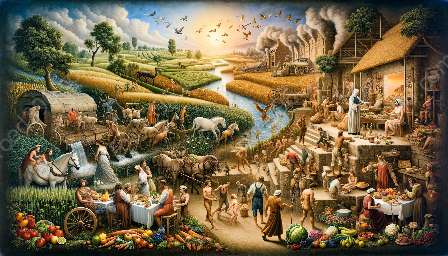During the medieval period, farming and agricultural systems played a crucial role in shaping society, economics, and culture. This topic encompasses the historical developments in food production and agriculture and explores their impact on food culture and history. Throughout this comprehensive exploration, we will delve into the methods, technologies, and social implications of medieval farming and agricultural systems.
Historical Developments in Food Production and Agriculture
The medieval era was characterized by significant developments in food production and agriculture. The feudal system dictated land ownership and distribution, leading to distinct agricultural practices in different regions. The three-field system, crop rotation, and the use of animal labor were prominent features of medieval farming. Advances in agricultural tools and irrigation techniques also influenced food production.
Impact on Food Culture and History
The agricultural developments of the medieval period had a profound impact on food culture and history. The availability of certain crops, such as grains and vegetables, shaped the dietary habits of people in different regions. The surplus production facilitated trade and commerce, leading to the development of urban centers and the emergence of new food markets and culinary practices.
Medieval Farming Techniques and Technologies
Medieval farmers employed a variety of techniques and technologies to cultivate the land and maximize yields. Plows, harrows, and sickles were essential tools for tilling and harvesting crops. Oxen and horses were also integral to agricultural labor, providing the necessary power for plowing and transportation. Additionally, the construction of water mills and windmills revolutionized grain processing and contributed to the growth of milling and baking industries.
Social Implications of Agricultural Systems
The agricultural systems of the medieval period had profound social implications, shaping the structure of society and the distribution of labor. Peasants and serfs toiled the fields, while the church and nobility held significant land holdings. The manorial system governed the relationship between the lord of the manor and the peasants, influencing labor obligations and resource allocation.
The Evolution of Farming Communities
As agricultural practices evolved, farming communities began to form distinct identities based on their crops, livestock, and geographical location. The development of specialized agricultural regions led to the cultivation of unique crops and the creation of localized food cultures. These communities contributed to the diversification of agricultural practices and the exchange of agricultural knowledge.
International Exchange and Agricultural Innovation
The medieval era witnessed international exchange and the dissemination of agricultural knowledge across regions. The introduction of new crops, such as spices and exotic fruits, transformed culinary traditions and contributed to the globalization of food culture. Additionally, innovations in agricultural techniques, such as crop rotation and soil management, spread through trade routes, promoting sustainable farming practices.
Challenges and Resilience in Agricultural Systems
Medieval farming faced numerous challenges, including natural disasters, pests, and fluctuations in climate. Agricultural communities demonstrated resilience by adapting to these challenges and developing innovative solutions. The management of agricultural risks and the implementation of diverse farming strategies were essential for sustaining food production in the face of adversity.
The Legacy of Medieval Farming and Agricultural Systems
The legacy of medieval farming and agricultural systems continues to influence contemporary food production and agricultural practices. Many modern farming techniques have roots in medieval methods, and the cultural impact of regional agricultural traditions is still evident in culinary diversity and food heritage.

